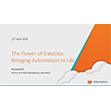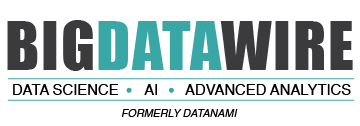
Why Embedded Analytics Are the Foundation of a Successful Application

(ZinetroN/Shutterstock)
Is your application starting to become irrelevant?
Or, put another way, is your application focusing only on facilitating the transactional parts of the customer interaction process while missing an opportunity to also provide critical insights? Because if your application is, it’s losing value. Sure, transactional tasks are getting automated, say sales or inventory management. A transactional report is getting generated. But is the business task itself getting done better or faster?
Embedding a layer of analytics into your existing application, on the other hand, is a pathway to delivering better results rather than just statistics because in-app analytics is a conduit to better decision-making.
Data analysis is no longer the sole domain of a few highly trained technical people. Today, amid the rise of data discovery, making the most of analytics falls on business leaders and other users as much as IT teams. Everyone is expected to be aware of their business domain data to make the right business decisions.
Application teams are now expected to simplify the difficult tasks of data preparation and visualization. Gleaning insight from near-real-time data, visualizations, interactive reports and other capabilities allow application teams to stay ahead of the curve on what’s needed next.
Embedded analytics are the foundation of successful application optimization. Here’s a closer look at how they can save time, increase productivity, lead to innovation and serve customers better.
Centralizing and Automating Analytics to Save Valuable Time
With an analytics layer embedded in your application workflow, you can centralize and automate analytics and reporting processes in near-real time.
Say your organization has dozens of locations, each generating dozens of business metrics, whether data on sales, staffing, inventory or numerous other factors. The data is invaluable. Finding actionable insights, however, might be insufferable without an in-app analytics solution that aggregates and reports the data in a consistent way across locations.
Otherwise, how much time would employees spend gathering the data? How much time would managers or IT teams spend generating reports? Siloed reporting models incur significant development time and restrict the sharing of data that users need.
Automated data gathering and reporting through embedded analytics can yield insights in near-real-time. Managers, team members and members of other teams can review benchmark categories right from a mobile device.
The net result is increased productivity, real-time feedback and efficiency. Embedded Analytics enables business users to spend less time switching back and forth between business applications and analytics tools, and more time on value-added activities.
A More Detailed and Helpful Visual Understanding
Embedded analytics provide application team leaders far more insight than what, say, traditional business intelligence affords. Traditional BI leans on static, often dated reports. Embedded analytics provide more near real-time data analysis and reporting capabilities.
Tools include dashboards and data visualizations of performance metrics, interactive reports with scheduling capabilities, self-service analytics and ad hoc querying to explore user-unique inquiries, benchmarking to compare metrics against peers or other external data, and mobile reporting.
Users get frustrated when basic data analysis capabilities prevent them from aggregating their own data or creating visualizations. Embedded analytics helps application development teams to innovate faster and increase customer satisfaction. The data and insights can yield new features or new use structures and reduce development time. Superior analytics and reporting experience increase customer engagement and draw new customers.
Gaining a Competitive Edge
Application teams have access to near-real-time data to guide decision-making when expectations for turnaround times only grow tighter. With self-service abilities, they can build dashboards and reports that could be tailored by individual business users to their needs. This improves the productivity of the business users so they can spend more time on your core business aspects that set you apart from your competitors. This in turn frees up application teams to focus on new products that help grow the business and create differentiation in the marketplace.
Whether through the additional insights or time gained, embedded analytics reveal new processes and opportunities. They drive innovation.
To remain relevant, an application must do more than yield a set of results or perform a set of tasks. Such a narrow view of its function ignores myriad other opportunities that embedded analytics can reveal. An application’s goal shouldn’t just be transactional (tracking sales activity or managing inventory). The goal should be about selling better and giving a better customer experience of your products. Actionable insights layered inside of existing applications give the business user makes them productive and make better business decisions.
The choice is up to your organization. It can keep plugging along like the more than half of the respondents to an executive survey who said they were not yet treating data as a business asset. Or your organization can embrace data and give your application teams the right embedded analytics tool to take insights and decision-making to the next level, where your organization reaches a wider customer base, expands profitability and remains competitive and relevant in the marketplace.
About the Author: Vijay Pendyala is the SVP of Engineering at Logi Analytics. He has been working in the high-tech industry with a focus on enterprise software, big data analytics, artificial intelligence (AI). For over 20+ years Vijay has held senior and executive-level roles in engineering, product management, data science, and SaaS operations. As a senior leadership team (SLT) member, Vijay has direct responsibility for leading Architecture, Engineering, Data Science, DevOps, and SaaS Operations. My primary responsibilities include building high-performance teams through the software development lifecycle, growing revenue, improving operating margins, and building market-leading products.
Related Items:
Insightsoftware Loads Up on Embedded Analytics with Logi, Izenda Deals
Embedded Analytics Goes Mainstream
April 23, 2025
- Metomic Introduces AI Data Protection Solution Amid Rising Concerns Over Sensitive Data Exposure in AI Tools
- Astronomer Unveils Apache Airflow 3 to Power AI and Real-Time Data Workflows
- CNCF Announces OpenObservabilityCon North America
- Domino Wins $16.5M DOD Award to Power Navy AI Infrastructure for Mine Detection
- Endor Labs Raises $93M to Expand AI-Powered AppSec Platform
- Ocient Announces Close of Series B Extension Financing to Accelerate Solutions for Complex Data and AI Workloads
April 22, 2025
- O’Reilly Launches AI Codecon, New Virtual Conference Series on the Future of AI-Enabled Development
- Qlik Powers Alpha Auto Group’s Global Growth with Automotive-Focused Analytics
- Docker Extends AI Momentum with MCP Tools Built for Developers
- John Snow Labs Unveils End-to-End HCC Coding Solution at Healthcare NLP Summit
- PingCAP Expands TiDB with Vector Search, Multi-Cloud Support for AI Workloads
- Qumulo Launches New Pricing in AWS Marketplace
April 21, 2025
- MIT: Making AI-Generated Code More Accurate in Any Language
- Cadence Introduces Industry-First DDR5 12.8Gbps MRDIMM Gen2 IP on TSMC N3 for Cloud AI
- BigDATAwire Unveils 2025 People to Watch
April 18, 2025
- Snowflake and PostgreSQL Among Top Climbers in DB-Engines Rankings
- Capital One Software Unveils Capital One Databolt to Help Companies Tokenize Sensitive Data at Scale
- Salesforce Launches Tableau Next to Streamline Data-to-Action with Agentic Analytics
- DataVisor Named a Leader in Forrester Wave for AML Solutions, Q2 2025
- GitLab Announces the General Availability of GitLab Duo with Amazon Q
- PayPal Feeds the DL Beast with Huge Vault of Fraud Data
- OpenTelemetry Is Too Complicated, VictoriaMetrics Says
- Will Model Context Protocol (MCP) Become the Standard for Agentic AI?
- Thriving in the Second Wave of Big Data Modernization
- What Benchmarks Say About Agentic AI’s Coding Potential
- Google Cloud Preps for Agentic AI Era with ‘Ironwood’ TPU, New Models and Software
- Google Cloud Fleshes Out its Databases at Next 2025, with an Eye to AI
- Accelerating Agentic AI Productivity with Enterprise Frameworks
- Can We Learn to Live with AI Hallucinations?
- Monte Carlo Brings AI Agents Into the Data Observability Fold
- More Features…
- Grafana’s Annual Report Uncovers Key Insights into the Future of Observability
- Google Cloud Cranks Up the Analytics at Next 2025
- New Intel CEO Lip-Bu Tan Promises Return to Engineering Innovation in Major Address
- AI One Emerges from Stealth to “End the Data Lake Era”
- SnapLogic Connects the Dots Between Agents, APIs, and Work AI
- Snowflake Bolsters Support for Apache Iceberg Tables
- GigaOM Report Highlights Top Performers in Unstructured Data Management for 2025
- Reporter’s Notebook: AI Hype and Glory at Nvidia GTC 2025
- Mathematica Helps Crack Zodiac Killer’s Code
- Big Growth Forecasted for Big Data
- More News In Brief…
- Gartner Predicts 40% of Generative AI Solutions Will Be Multimodal By 2027
- MinIO: Introducing Model Context Protocol Server for MinIO AIStor
- Dataiku Achieves AWS Generative AI Competency
- AMD Powers New Google Cloud C4D and H4D VMs with 5th Gen EPYC CPUs
- Prophecy Introduces Fully Governed Self-Service Data Preparation for Databricks SQL
- Seagate Unveils IronWolf Pro 24TB Hard Drive for SMBs and Enterprises
- CData Launches Microsoft Fabric Integration Accelerator
- MLCommons Releases New MLPerf Inference v5.0 Benchmark Results
- Opsera Raises $20M to Expand AI-Driven DevOps Platform
- GitLab Announces the General Availability of GitLab Duo with Amazon Q
- More This Just In…




























